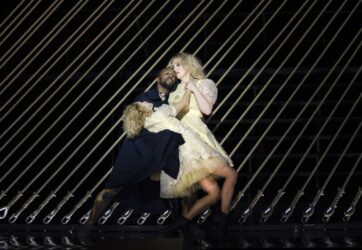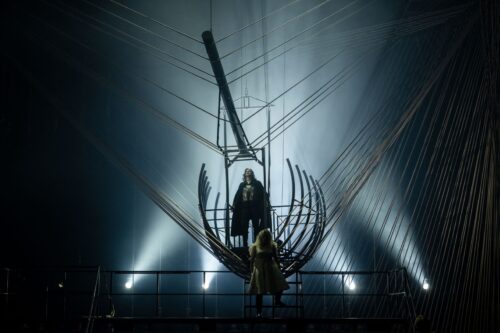 Germany Wagner, Der fliegende Holländer: Soloists, Chorus and Orchestra of Nationaltheater Mannheim / Jordan de Souza (conductor). Livestreamed (directed by Florian Breuer) on 24.4.2022 from the Nationaltheater Mannheim (available on YouTube and OperaVision until 24.10.2022). (JPr)
Germany Wagner, Der fliegende Holländer: Soloists, Chorus and Orchestra of Nationaltheater Mannheim / Jordan de Souza (conductor). Livestreamed (directed by Florian Breuer) on 24.4.2022 from the Nationaltheater Mannheim (available on YouTube and OperaVision until 24.10.2022). (JPr)

Production:
Director – Roger Vontobel
Associate director – Maren Schäfer
Set designer – Fabian Wendling
Costume designer – Ellen Hofmann
Lighting designer – Florian Arnholdt
Choreographer – Zenta Haerter
Video director – Stefan Bischoff
Dramaturgy – Deborah Maier, Marion Tiedtke
Chorus master – Dani Juris
Cast:
Daland – Sung Ha
Senta – Daniela Köhler
Erik – Jonathan Stoughton
Mary – Marie-Belle Sandis
Steersman – Juraj Hollý
The Dutchman – Michael Kupfer-Radecky
Dream Senta – Delphina Parenti
Dream Dutchman – Michael Bronczkowski
A first visit to opera in Mannheim (courtesy of OperaVision) and their new production of Der fliegende Holländer. At the end it was very well received and it seems audiences there are open to theatrical excess when what Roger Vontobel’s staging confirmed was an old adage that ‘less is more’. If only the director had greater confidence in the dramatic abilities of his singers there might have been less of the annoying distractions that spoilt an otherwise engrossing musical performance (at least as heard through my loudspeakers).
Obviously, there wasn’t much money available for Fabian Wendling’s sets and there was only some banked seating rising to a gangway at the top that served – in various ways – for all three acts which were performed without any interval. It was the prow of Daland’s ship with a searchlight for the Steersman; then the gallery where the overseers of the factory girls were oddly putting them into pink girdles; and then the setting for the ‘partying’ of Daland’s men and the girls and their encounter with the Dutchman’s ghostly crew. The performing space was fringed by a large number of stage deep ropes with counterweights at the end which were played about with throughout the opera and benefited from some imaginative lighting from Florian Arnholdt and – sometimes with the help of dry ice – gave a very atmospheric sense of entrapment at times. Quite brilliant was the Flying Dutchman’s ghost ship which from time to time hovered over the action as a metallic skeletal keel and reminded me of the ribcage of ‘Hope’, the blue whale skeleton in London’s Natural History Museum.

There was also effective use of video from Stefan Bischoff particularly near the end of the overture when we saw stormy seas, ropes and netting, plankton, sea birds, culminating in focusing on Senta’s face before dimly showing us the figure of the Dutchman. Another plus of this livestream was Florian Breuer’s camerawork taking us onstage and into the heart of the action on occasions. There was a lot of mascara on show and Ellen Hofmann’s costumes generally had the men in dark and dowdy colours, Daland had a red velvet jacket, Mary s costumed like Rosa Klebb in the Bond film From Russia with Love, the girls of the ‘Spinning Chorus’ were in white slips and Senta was in a white wedding dress.
All the above were mostly pluses but there were a number of negatives and the worst of all was doubling the roles of the Dutchman and Senta with two dancers (as Dream figures) who shadowed and frequently interacted with the singers, as well as the ropes. Zenta Haerter’s angst-ridden contemporary choreography was probably attempting to give a physical representation of the characters’ emotions, thoughts, desires, feelings, fears and much more. It is only the Dream Dutchman (Michael Bronczkowski) who climbs down from the ship at the beginning but both the Dutchman and his alter ego begin an ascent to heaven at the end as Senta promises to be true to him unto death. It will be Dream Senta (Delphina Parenti) who will rise up after them while the opera finishes with a haunting video image of a dead Senta. The use of doppelgängers is not a novel idea and has been used before but it is overdone here. Vontobel also seems to show more than once that Senta is self-absorbed and perhaps that explains his depiction of the throuple relationship of Senta, Dream Senta and the Dutchman. Was anyone redeemed? Was the whole thing just a young girl’s fantasy of romantic love? In fact on first encountering the Dutchman, Senta does seem to baulk at her father’s insistence at her forced marriage to the stranger in front of her.
Also totally unnecessary is the bullying of the Steersman by Daland’s men during all the ‘merry-making’ for no apparent reason and he will end up beaten up and bloodied. The men’s crude gestures and obvious physical abuse of some of the girls was also unacceptable in 2022.
I suspect there were a number of role debuts in this performance and the most significant were of course those of Michael Kupfer-Radecky and Daniela Köhler as the Dutchman and Senta. Seeking salvation through a woman’s unconditional love, Kupfer-Radecky’s tormented Dutchman was gloomy, accursed, world-weary, somewhat Byronic, and as a result, surprisingly charismatic. His clear and expressive baritone had power when required but also considerable Lieder-like elegance and expressivity. He is a new name to me but is well worth seeking out in future. As the self-sacrificing Senta, Daniela Köhler began by singing her demanding opening ballad with convincing intensity and her soprano voice was warm and secure. She was well-matched with Kupfer-Radecky during their duet but sounded increasingly tentative and shriller as the opera went on. I am intrigued to see she will be singing the Siegfried Brünnhilde this summer in Bayreuth.
Sung Ha portrayed Daland as rather aloof, exceedingly avaricious and somewhat too willing to pimp his daughter to a mysterious suitor in exchange for some jewels. Ha’s singing was rather straight-forward and colourless. The rest of the roles in Der fliegende Holländer are largely underwritten and Erik, Senta’s erstwhile boyfriend, can do little but suggest someone rejected and lovelorn. It needed a little more than Jonathan Stoughton’s stock gestures and – to be truthful – he spent more time thinking about what he was singing rather than about his acting. His heroic tenor voice remains one of considerable potential however his ‘Senta! O Senta!’ has challenged some legendary singers over the years and it was not Stoughton’s fault it was not entirely blemish-free. Marie-Belle Sandis was a suitably stern Mary and Juraj Hollý an appealing, yet ultimately browbeaten Steersman.
The men of the chorus sang out in uninhibited fashion while the women sounded a little more reticent. What impressed me most was the sound from the Orchestra of the Nationaltheater Mannheim and Jordan de Souza appeared to conduct with tight control, energy, vitality, and rhythmic elan.
Jim Pritchard

I’m new to watching Wagner, but now, since it’s available due to YouTube, a new world has been opened. I’ve done a little study of Wagner’s work, thanks to The Great Courses and Dr. Greenberg. This production is the first I’ve watched. It perplexed me. I don’t understand the need for the dancers. Why are they there? The singers seemed to be forced apart to accommodate them.
The singing and music are great, but the staging is confusing to me. Perhaps those more familiar with the work will understand it.
The Flying Dutchman theme is one of those tunes that sings in my head at proper moments. Bravo Wagner!